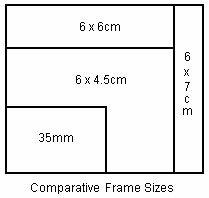Medium format is a term used to describe a number of quite different image sizes and aspect ratios, but all offer substantially larger image area than the familiar 35mm format. Images produced for the 35mm format measure 24 x 36mm. Those for the smallest medium format of 6 x 4.5cm give an increase in image area of about 2.7 times. This is sufficient to give clearly increased image quality which cannot be matched by the 35mm format. Medium format images viewed on a light box are also immediately more impressive for picture editors. Another advantage is that when medium format images are enlarged and printed they remain sharper and less grainy, and retain greater colour saturation.
 The next step up in image size within the medium format range is the square 6 x6 cm format. This has significant implications for image composition and may require some adjustment of technique for those accustomed to the rectangular 35mm format. Ironically, some photographers later crop their images to return to the more familiar rectangular format. The 6 x 6cm format is popular with wedding and portrait photographers, but photographers who do not like square images should probably avoid it. Cropping images down to rectangle removes the advantage this format has over the 6 x 4.5cm format.
The next step up in image size within the medium format range is the square 6 x6 cm format. This has significant implications for image composition and may require some adjustment of technique for those accustomed to the rectangular 35mm format. Ironically, some photographers later crop their images to return to the more familiar rectangular format. The 6 x 6cm format is popular with wedding and portrait photographers, but photographers who do not like square images should probably avoid it. Cropping images down to rectangle removes the advantage this format has over the 6 x 4.5cm format.
The largest image size within the medium range is provided by the 6 x 7cm format. This is a very significant step up from 35mm in terms of image size and quality. Image area is 4.5 times greater than for the 35mm format, and more than 1.5 times larger than for the 6 x 4.5cm format. The advantages are clear, but the disadvantages also begin to show in terms of the increased cost, weight and size of cameras and equipment. The 6 x 7cm format is therefore mainly used by landscape photographers and in studios.






